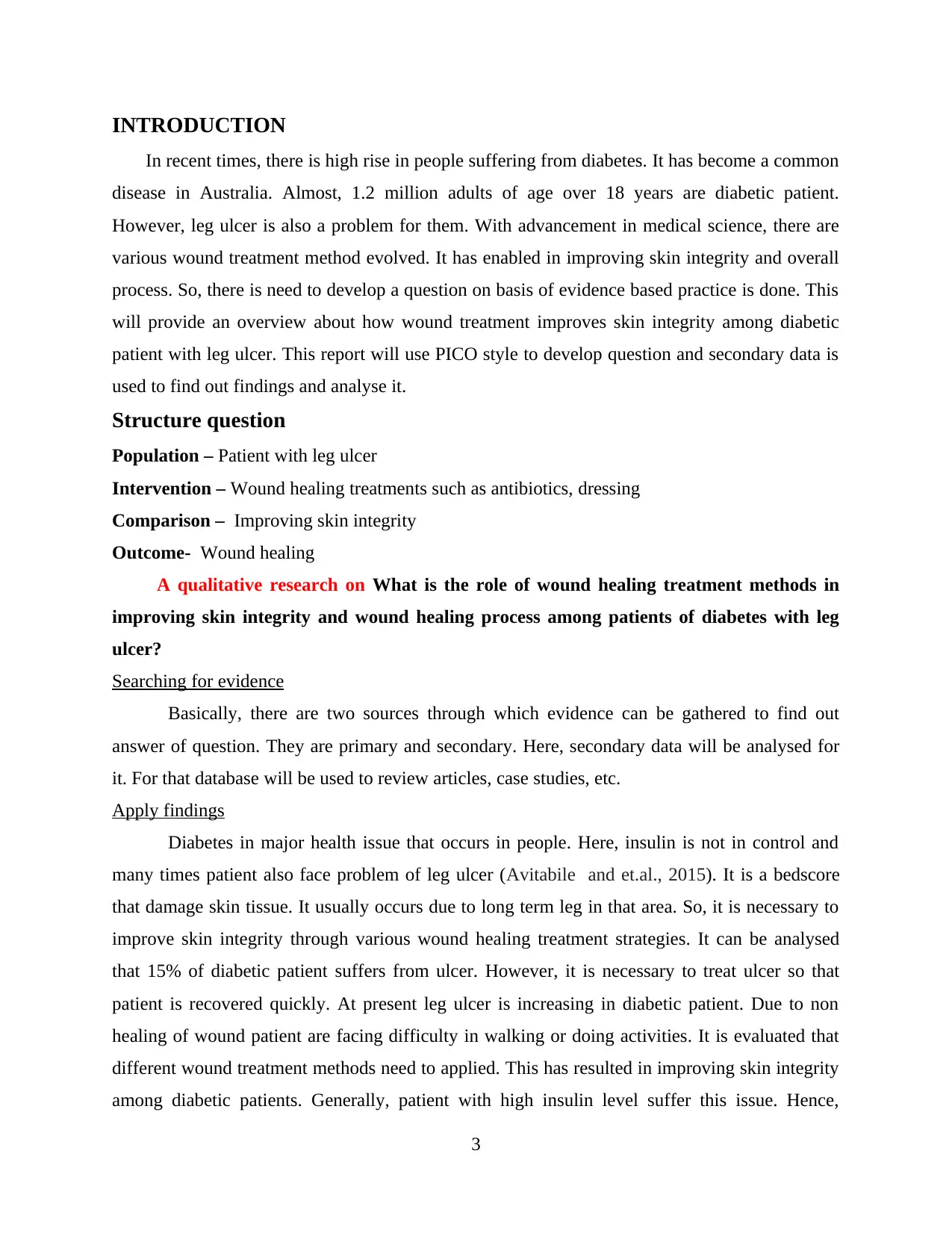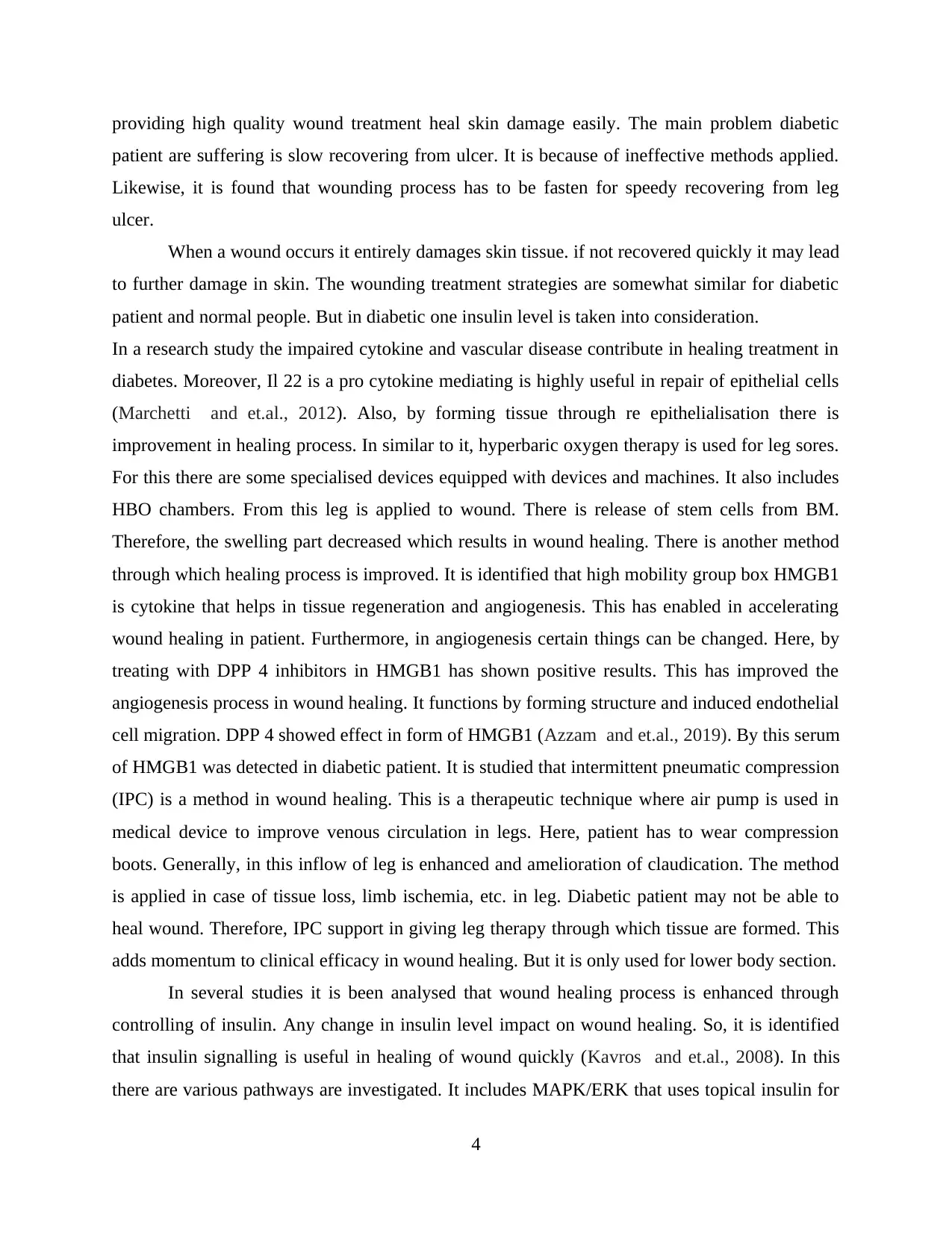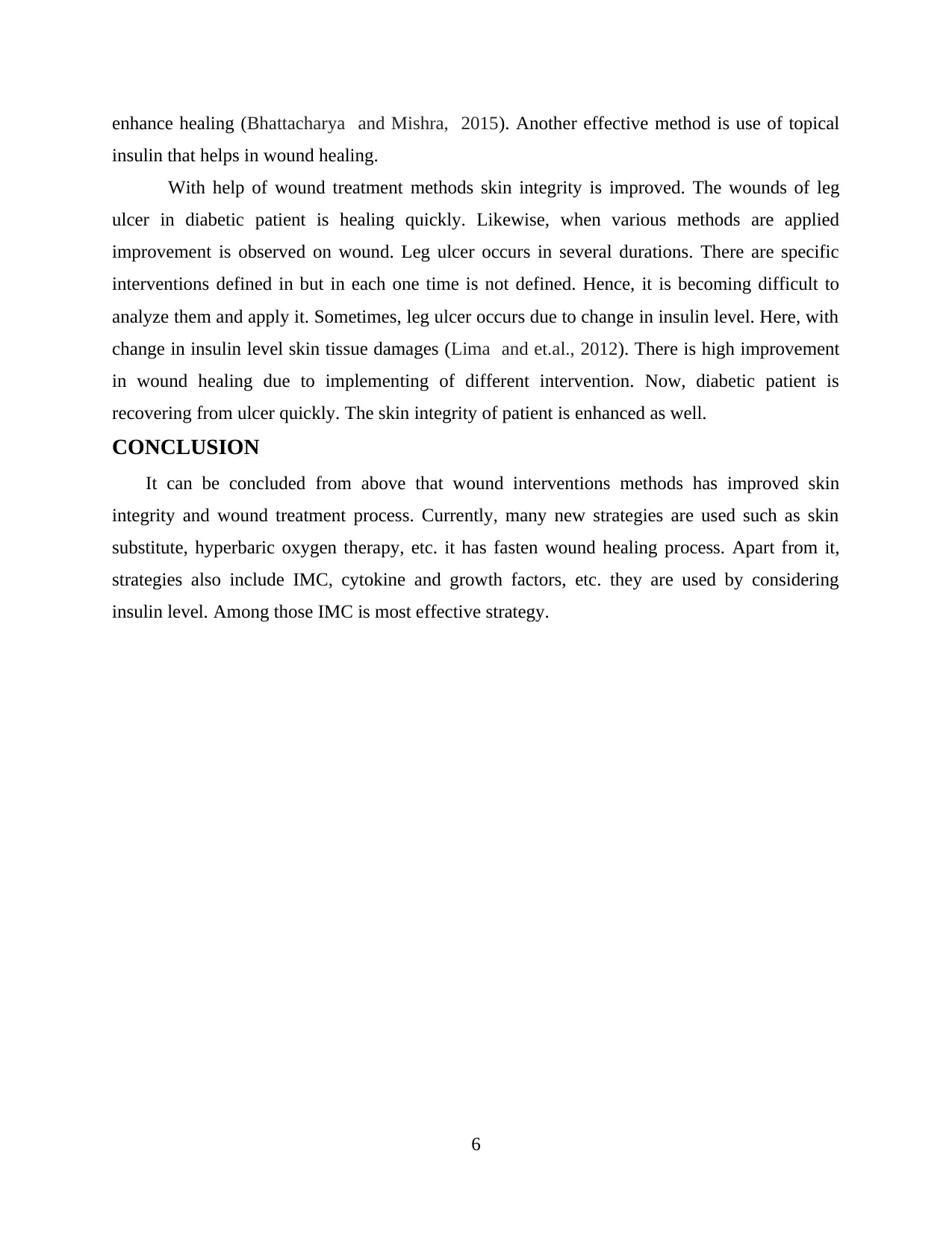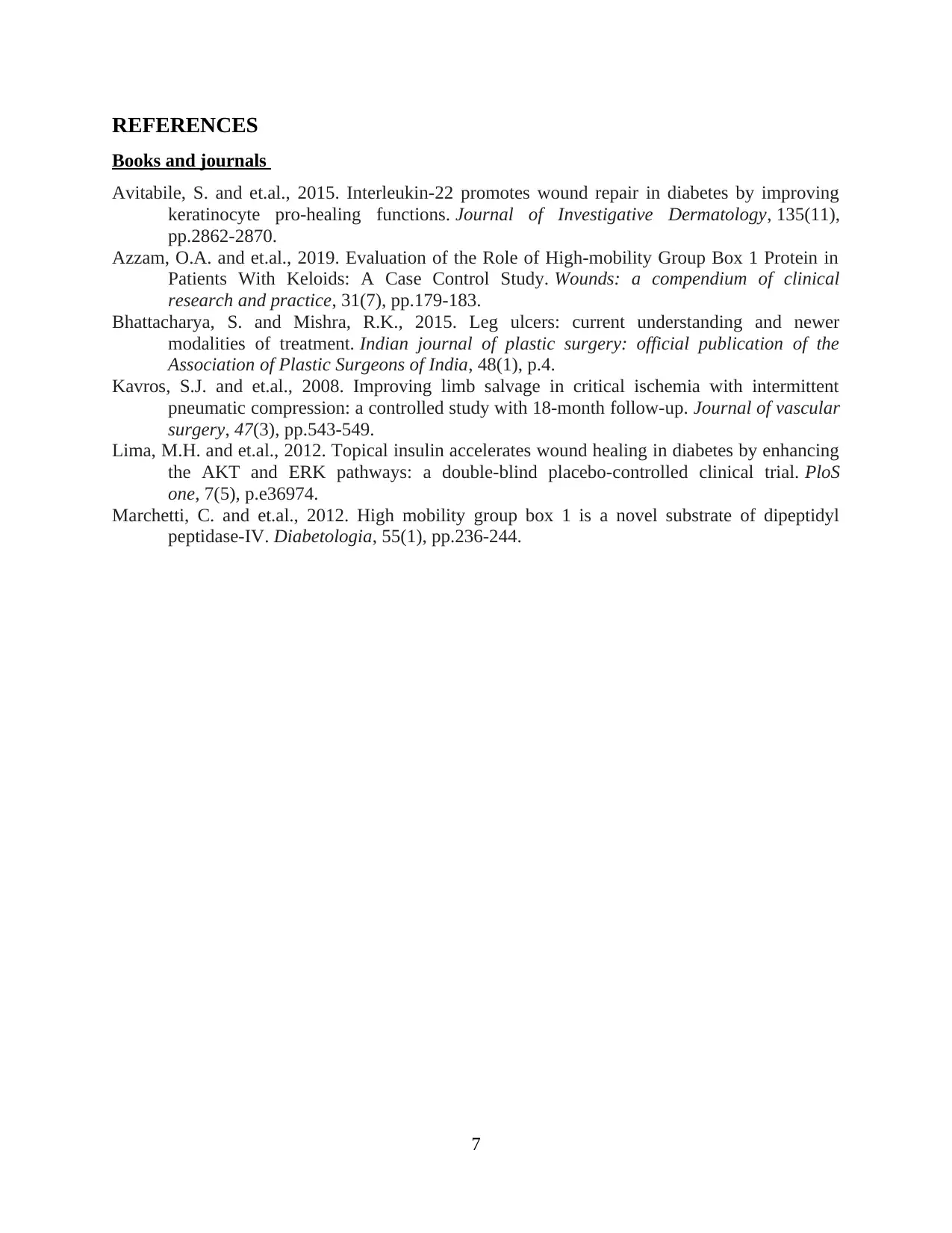Evidence-Based Wound Healing Treatments for Diabetic Leg Ulcers Report
VerifiedAdded on 2021/02/21
|7
|1933
|183
Report
AI Summary
This report delves into the critical issue of wound healing, particularly in diabetic patients suffering from leg ulcers, a common and challenging complication. It employs the PICO framework to structure the clinical question and explores various evidence-based treatment methods to improve skin integrity and wound healing. The report analyzes secondary data, including research articles and case studies, to evaluate the efficacy of different interventions such as antibiotics, dressings, skin substitutes, hyperbaric oxygen therapy, and intermittent pneumatic compression (IPC). It highlights the role of factors like insulin levels, cytokines (e.g., Il-22, HMGB1), and pathways (e.g., MAPK/ERK) in wound healing. The findings emphasize the importance of tailored treatment strategies considering the patient's condition and the potential benefits of interventions like IPC and topical insulin. The report concludes that evidence-based wound interventions have significantly improved outcomes for diabetic patients with leg ulcers, emphasizing the need for continued research and the application of new strategies to enhance patient recovery and skin integrity.

Formulating clinical
questions and searching
for evidence
1
questions and searching
for evidence
1
Paraphrase This Document
Need a fresh take? Get an instant paraphrase of this document with our AI Paraphraser

Table of Contents
INTRODUCTION...........................................................................................................................3
Structure question............................................................................................................................3
Searching for evidence................................................................................................................3
Apply findings.............................................................................................................................3
CONCLUSION................................................................................................................................6
REFERENCES................................................................................................................................7
2
INTRODUCTION...........................................................................................................................3
Structure question............................................................................................................................3
Searching for evidence................................................................................................................3
Apply findings.............................................................................................................................3
CONCLUSION................................................................................................................................6
REFERENCES................................................................................................................................7
2

INTRODUCTION
In recent times, there is high rise in people suffering from diabetes. It has become a common
disease in Australia. Almost, 1.2 million adults of age over 18 years are diabetic patient.
However, leg ulcer is also a problem for them. With advancement in medical science, there are
various wound treatment method evolved. It has enabled in improving skin integrity and overall
process. So, there is need to develop a question on basis of evidence based practice is done. This
will provide an overview about how wound treatment improves skin integrity among diabetic
patient with leg ulcer. This report will use PICO style to develop question and secondary data is
used to find out findings and analyse it.
Structure question
Population – Patient with leg ulcer
Intervention – Wound healing treatments such as antibiotics, dressing
Comparison – Improving skin integrity
Outcome- Wound healing
A qualitative research on What is the role of wound healing treatment methods in
improving skin integrity and wound healing process among patients of diabetes with leg
ulcer?
Searching for evidence
Basically, there are two sources through which evidence can be gathered to find out
answer of question. They are primary and secondary. Here, secondary data will be analysed for
it. For that database will be used to review articles, case studies, etc.
Apply findings
Diabetes in major health issue that occurs in people. Here, insulin is not in control and
many times patient also face problem of leg ulcer (Avitabile and et.al., 2015). It is a bedscore
that damage skin tissue. It usually occurs due to long term leg in that area. So, it is necessary to
improve skin integrity through various wound healing treatment strategies. It can be analysed
that 15% of diabetic patient suffers from ulcer. However, it is necessary to treat ulcer so that
patient is recovered quickly. At present leg ulcer is increasing in diabetic patient. Due to non
healing of wound patient are facing difficulty in walking or doing activities. It is evaluated that
different wound treatment methods need to applied. This has resulted in improving skin integrity
among diabetic patients. Generally, patient with high insulin level suffer this issue. Hence,
3
In recent times, there is high rise in people suffering from diabetes. It has become a common
disease in Australia. Almost, 1.2 million adults of age over 18 years are diabetic patient.
However, leg ulcer is also a problem for them. With advancement in medical science, there are
various wound treatment method evolved. It has enabled in improving skin integrity and overall
process. So, there is need to develop a question on basis of evidence based practice is done. This
will provide an overview about how wound treatment improves skin integrity among diabetic
patient with leg ulcer. This report will use PICO style to develop question and secondary data is
used to find out findings and analyse it.
Structure question
Population – Patient with leg ulcer
Intervention – Wound healing treatments such as antibiotics, dressing
Comparison – Improving skin integrity
Outcome- Wound healing
A qualitative research on What is the role of wound healing treatment methods in
improving skin integrity and wound healing process among patients of diabetes with leg
ulcer?
Searching for evidence
Basically, there are two sources through which evidence can be gathered to find out
answer of question. They are primary and secondary. Here, secondary data will be analysed for
it. For that database will be used to review articles, case studies, etc.
Apply findings
Diabetes in major health issue that occurs in people. Here, insulin is not in control and
many times patient also face problem of leg ulcer (Avitabile and et.al., 2015). It is a bedscore
that damage skin tissue. It usually occurs due to long term leg in that area. So, it is necessary to
improve skin integrity through various wound healing treatment strategies. It can be analysed
that 15% of diabetic patient suffers from ulcer. However, it is necessary to treat ulcer so that
patient is recovered quickly. At present leg ulcer is increasing in diabetic patient. Due to non
healing of wound patient are facing difficulty in walking or doing activities. It is evaluated that
different wound treatment methods need to applied. This has resulted in improving skin integrity
among diabetic patients. Generally, patient with high insulin level suffer this issue. Hence,
3
⊘ This is a preview!⊘
Do you want full access?
Subscribe today to unlock all pages.

Trusted by 1+ million students worldwide

providing high quality wound treatment heal skin damage easily. The main problem diabetic
patient are suffering is slow recovering from ulcer. It is because of ineffective methods applied.
Likewise, it is found that wounding process has to be fasten for speedy recovering from leg
ulcer.
When a wound occurs it entirely damages skin tissue. if not recovered quickly it may lead
to further damage in skin. The wounding treatment strategies are somewhat similar for diabetic
patient and normal people. But in diabetic one insulin level is taken into consideration.
In a research study the impaired cytokine and vascular disease contribute in healing treatment in
diabetes. Moreover, Il 22 is a pro cytokine mediating is highly useful in repair of epithelial cells
(Marchetti and et.al., 2012). Also, by forming tissue through re epithelialisation there is
improvement in healing process. In similar to it, hyperbaric oxygen therapy is used for leg sores.
For this there are some specialised devices equipped with devices and machines. It also includes
HBO chambers. From this leg is applied to wound. There is release of stem cells from BM.
Therefore, the swelling part decreased which results in wound healing. There is another method
through which healing process is improved. It is identified that high mobility group box HMGB1
is cytokine that helps in tissue regeneration and angiogenesis. This has enabled in accelerating
wound healing in patient. Furthermore, in angiogenesis certain things can be changed. Here, by
treating with DPP 4 inhibitors in HMGB1 has shown positive results. This has improved the
angiogenesis process in wound healing. It functions by forming structure and induced endothelial
cell migration. DPP 4 showed effect in form of HMGB1 (Azzam and et.al., 2019). By this serum
of HMGB1 was detected in diabetic patient. It is studied that intermittent pneumatic compression
(IPC) is a method in wound healing. This is a therapeutic technique where air pump is used in
medical device to improve venous circulation in legs. Here, patient has to wear compression
boots. Generally, in this inflow of leg is enhanced and amelioration of claudication. The method
is applied in case of tissue loss, limb ischemia, etc. in leg. Diabetic patient may not be able to
heal wound. Therefore, IPC support in giving leg therapy through which tissue are formed. This
adds momentum to clinical efficacy in wound healing. But it is only used for lower body section.
In several studies it is been analysed that wound healing process is enhanced through
controlling of insulin. Any change in insulin level impact on wound healing. So, it is identified
that insulin signalling is useful in healing of wound quickly (Kavros and et.al., 2008). In this
there are various pathways are investigated. It includes MAPK/ERK that uses topical insulin for
4
patient are suffering is slow recovering from ulcer. It is because of ineffective methods applied.
Likewise, it is found that wounding process has to be fasten for speedy recovering from leg
ulcer.
When a wound occurs it entirely damages skin tissue. if not recovered quickly it may lead
to further damage in skin. The wounding treatment strategies are somewhat similar for diabetic
patient and normal people. But in diabetic one insulin level is taken into consideration.
In a research study the impaired cytokine and vascular disease contribute in healing treatment in
diabetes. Moreover, Il 22 is a pro cytokine mediating is highly useful in repair of epithelial cells
(Marchetti and et.al., 2012). Also, by forming tissue through re epithelialisation there is
improvement in healing process. In similar to it, hyperbaric oxygen therapy is used for leg sores.
For this there are some specialised devices equipped with devices and machines. It also includes
HBO chambers. From this leg is applied to wound. There is release of stem cells from BM.
Therefore, the swelling part decreased which results in wound healing. There is another method
through which healing process is improved. It is identified that high mobility group box HMGB1
is cytokine that helps in tissue regeneration and angiogenesis. This has enabled in accelerating
wound healing in patient. Furthermore, in angiogenesis certain things can be changed. Here, by
treating with DPP 4 inhibitors in HMGB1 has shown positive results. This has improved the
angiogenesis process in wound healing. It functions by forming structure and induced endothelial
cell migration. DPP 4 showed effect in form of HMGB1 (Azzam and et.al., 2019). By this serum
of HMGB1 was detected in diabetic patient. It is studied that intermittent pneumatic compression
(IPC) is a method in wound healing. This is a therapeutic technique where air pump is used in
medical device to improve venous circulation in legs. Here, patient has to wear compression
boots. Generally, in this inflow of leg is enhanced and amelioration of claudication. The method
is applied in case of tissue loss, limb ischemia, etc. in leg. Diabetic patient may not be able to
heal wound. Therefore, IPC support in giving leg therapy through which tissue are formed. This
adds momentum to clinical efficacy in wound healing. But it is only used for lower body section.
In several studies it is been analysed that wound healing process is enhanced through
controlling of insulin. Any change in insulin level impact on wound healing. So, it is identified
that insulin signalling is useful in healing of wound quickly (Kavros and et.al., 2008). In this
there are various pathways are investigated. It includes MAPK/ERK that uses topical insulin for
4
Paraphrase This Document
Need a fresh take? Get an instant paraphrase of this document with our AI Paraphraser

wound healing. In this IR/IRS2 /AKT increases rate of healing tissue in wounds. AKT contain
phosphorylate protein and regulate lipid and glycogen synthesis. Here, it is observed in pathway
of that contribute in healing of skin. Topical Insulin directly impact on bone narrow. So, in
IR/IRS2 /AKT tissue changes in wound healing due to insulin signalling. Also, pathways
contribute in reducing time in wound healing. In wound healing basic treatment intervention is
using antibiotics and dressing which helps in healing. On basis of type of wound, antibiotics are
applied. Similarly, there are several ways and stages of wound healing. They are classified as
debriding, absorbent, etc. Thus, combination of both dressing and antibiotics remove dead tissue.
In dressing special bandage are used to speed up healing method. There are some wound that
require high antibiotics. They are to be applied daily in order to remove wound.
In addition to it, there are many other interventions used. Skin substitute is method where
damaged part is replaced with fresh skin. This is done because damages skin part is gets infected
and can not be healed. Besides, it becomes difficult to apply antibiotics or dressing on it. Thus,
damaged tissues are removed from it (Lima and et.al., 2012). It has also enabled in improving
wound process. The patient treatment is done on basis after inspecting leg ulcer. So, at first
antibiotics are applied and changes are observed for particular time period. Than if is no
improvement in it skin substitute is done.
Evaluating results
From above findings it can be observed that wound healing treatment play significant
role in improving skin integrity diabetic patient with leg ulcer. The methods or strategies applied
make changes in healing process. However, if strategies are implemented in effective way than
healing process starts quickly. There are different methods described above such as IPC, topical
insulin, etc. the Il 22 pro cytokine mediate epithelial cells. It promotes vascular endothelial
growth factor releases. Alongside it, IPC is also an effective technique as in this patient are given
therapy. But this strategy is used when there is chronic condition. However, IPC is best
intervention that can be used in improving healing process. The use of boots in it makes the flow
of blood easy. It fastens process of healing. Additionally, in IPC air flow can be controlled as per
wound. Besides, in critical case flow can be increased which improves wounding process. The
MAPK/ERK pathway is to be decided and then topical insulin is applied. The HMGB1 cytokine
regenerate tissue. It performs angiogenesis process that accelerate wound healing. HMGB1
contain DPP4 that changes biological activity of it. This improves angiogenesis process and
5
phosphorylate protein and regulate lipid and glycogen synthesis. Here, it is observed in pathway
of that contribute in healing of skin. Topical Insulin directly impact on bone narrow. So, in
IR/IRS2 /AKT tissue changes in wound healing due to insulin signalling. Also, pathways
contribute in reducing time in wound healing. In wound healing basic treatment intervention is
using antibiotics and dressing which helps in healing. On basis of type of wound, antibiotics are
applied. Similarly, there are several ways and stages of wound healing. They are classified as
debriding, absorbent, etc. Thus, combination of both dressing and antibiotics remove dead tissue.
In dressing special bandage are used to speed up healing method. There are some wound that
require high antibiotics. They are to be applied daily in order to remove wound.
In addition to it, there are many other interventions used. Skin substitute is method where
damaged part is replaced with fresh skin. This is done because damages skin part is gets infected
and can not be healed. Besides, it becomes difficult to apply antibiotics or dressing on it. Thus,
damaged tissues are removed from it (Lima and et.al., 2012). It has also enabled in improving
wound process. The patient treatment is done on basis after inspecting leg ulcer. So, at first
antibiotics are applied and changes are observed for particular time period. Than if is no
improvement in it skin substitute is done.
Evaluating results
From above findings it can be observed that wound healing treatment play significant
role in improving skin integrity diabetic patient with leg ulcer. The methods or strategies applied
make changes in healing process. However, if strategies are implemented in effective way than
healing process starts quickly. There are different methods described above such as IPC, topical
insulin, etc. the Il 22 pro cytokine mediate epithelial cells. It promotes vascular endothelial
growth factor releases. Alongside it, IPC is also an effective technique as in this patient are given
therapy. But this strategy is used when there is chronic condition. However, IPC is best
intervention that can be used in improving healing process. The use of boots in it makes the flow
of blood easy. It fastens process of healing. Additionally, in IPC air flow can be controlled as per
wound. Besides, in critical case flow can be increased which improves wounding process. The
MAPK/ERK pathway is to be decided and then topical insulin is applied. The HMGB1 cytokine
regenerate tissue. It performs angiogenesis process that accelerate wound healing. HMGB1
contain DPP4 that changes biological activity of it. This improves angiogenesis process and
5

enhance healing (Bhattacharya and Mishra, 2015). Another effective method is use of topical
insulin that helps in wound healing.
With help of wound treatment methods skin integrity is improved. The wounds of leg
ulcer in diabetic patient is healing quickly. Likewise, when various methods are applied
improvement is observed on wound. Leg ulcer occurs in several durations. There are specific
interventions defined in but in each one time is not defined. Hence, it is becoming difficult to
analyze them and apply it. Sometimes, leg ulcer occurs due to change in insulin level. Here, with
change in insulin level skin tissue damages (Lima and et.al., 2012). There is high improvement
in wound healing due to implementing of different intervention. Now, diabetic patient is
recovering from ulcer quickly. The skin integrity of patient is enhanced as well.
CONCLUSION
It can be concluded from above that wound interventions methods has improved skin
integrity and wound treatment process. Currently, many new strategies are used such as skin
substitute, hyperbaric oxygen therapy, etc. it has fasten wound healing process. Apart from it,
strategies also include IMC, cytokine and growth factors, etc. they are used by considering
insulin level. Among those IMC is most effective strategy.
6
insulin that helps in wound healing.
With help of wound treatment methods skin integrity is improved. The wounds of leg
ulcer in diabetic patient is healing quickly. Likewise, when various methods are applied
improvement is observed on wound. Leg ulcer occurs in several durations. There are specific
interventions defined in but in each one time is not defined. Hence, it is becoming difficult to
analyze them and apply it. Sometimes, leg ulcer occurs due to change in insulin level. Here, with
change in insulin level skin tissue damages (Lima and et.al., 2012). There is high improvement
in wound healing due to implementing of different intervention. Now, diabetic patient is
recovering from ulcer quickly. The skin integrity of patient is enhanced as well.
CONCLUSION
It can be concluded from above that wound interventions methods has improved skin
integrity and wound treatment process. Currently, many new strategies are used such as skin
substitute, hyperbaric oxygen therapy, etc. it has fasten wound healing process. Apart from it,
strategies also include IMC, cytokine and growth factors, etc. they are used by considering
insulin level. Among those IMC is most effective strategy.
6
⊘ This is a preview!⊘
Do you want full access?
Subscribe today to unlock all pages.

Trusted by 1+ million students worldwide

REFERENCES
Books and journals
Avitabile, S. and et.al., 2015. Interleukin-22 promotes wound repair in diabetes by improving
keratinocyte pro-healing functions. Journal of Investigative Dermatology, 135(11),
pp.2862-2870.
Azzam, O.A. and et.al., 2019. Evaluation of the Role of High-mobility Group Box 1 Protein in
Patients With Keloids: A Case Control Study. Wounds: a compendium of clinical
research and practice, 31(7), pp.179-183.
Bhattacharya, S. and Mishra, R.K., 2015. Leg ulcers: current understanding and newer
modalities of treatment. Indian journal of plastic surgery: official publication of the
Association of Plastic Surgeons of India, 48(1), p.4.
Kavros, S.J. and et.al., 2008. Improving limb salvage in critical ischemia with intermittent
pneumatic compression: a controlled study with 18-month follow-up. Journal of vascular
surgery, 47(3), pp.543-549.
Lima, M.H. and et.al., 2012. Topical insulin accelerates wound healing in diabetes by enhancing
the AKT and ERK pathways: a double-blind placebo-controlled clinical trial. PloS
one, 7(5), p.e36974.
Marchetti, C. and et.al., 2012. High mobility group box 1 is a novel substrate of dipeptidyl
peptidase-IV. Diabetologia, 55(1), pp.236-244.
7
Books and journals
Avitabile, S. and et.al., 2015. Interleukin-22 promotes wound repair in diabetes by improving
keratinocyte pro-healing functions. Journal of Investigative Dermatology, 135(11),
pp.2862-2870.
Azzam, O.A. and et.al., 2019. Evaluation of the Role of High-mobility Group Box 1 Protein in
Patients With Keloids: A Case Control Study. Wounds: a compendium of clinical
research and practice, 31(7), pp.179-183.
Bhattacharya, S. and Mishra, R.K., 2015. Leg ulcers: current understanding and newer
modalities of treatment. Indian journal of plastic surgery: official publication of the
Association of Plastic Surgeons of India, 48(1), p.4.
Kavros, S.J. and et.al., 2008. Improving limb salvage in critical ischemia with intermittent
pneumatic compression: a controlled study with 18-month follow-up. Journal of vascular
surgery, 47(3), pp.543-549.
Lima, M.H. and et.al., 2012. Topical insulin accelerates wound healing in diabetes by enhancing
the AKT and ERK pathways: a double-blind placebo-controlled clinical trial. PloS
one, 7(5), p.e36974.
Marchetti, C. and et.al., 2012. High mobility group box 1 is a novel substrate of dipeptidyl
peptidase-IV. Diabetologia, 55(1), pp.236-244.
7
1 out of 7
Related Documents
Your All-in-One AI-Powered Toolkit for Academic Success.
+13062052269
info@desklib.com
Available 24*7 on WhatsApp / Email
![[object Object]](/_next/static/media/star-bottom.7253800d.svg)
Unlock your academic potential
Copyright © 2020–2025 A2Z Services. All Rights Reserved. Developed and managed by ZUCOL.





